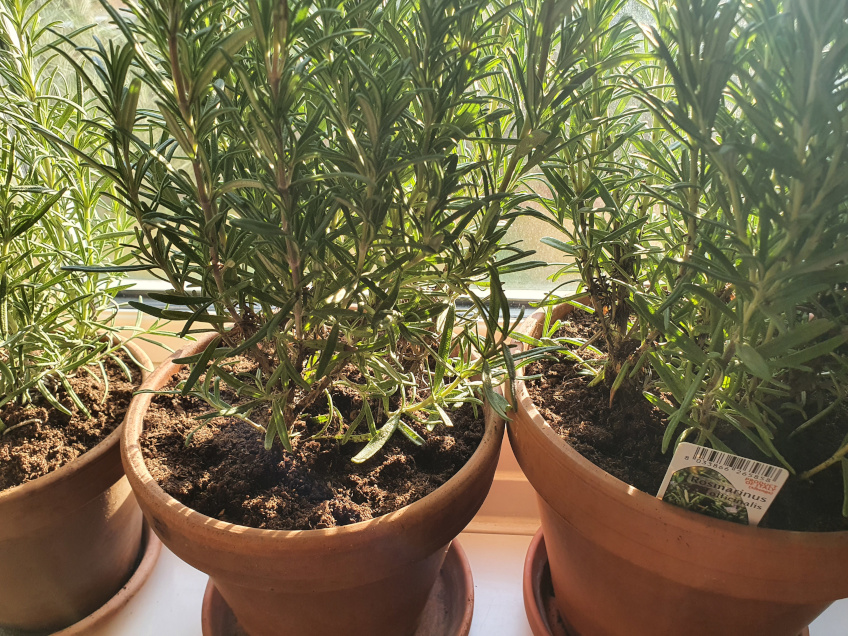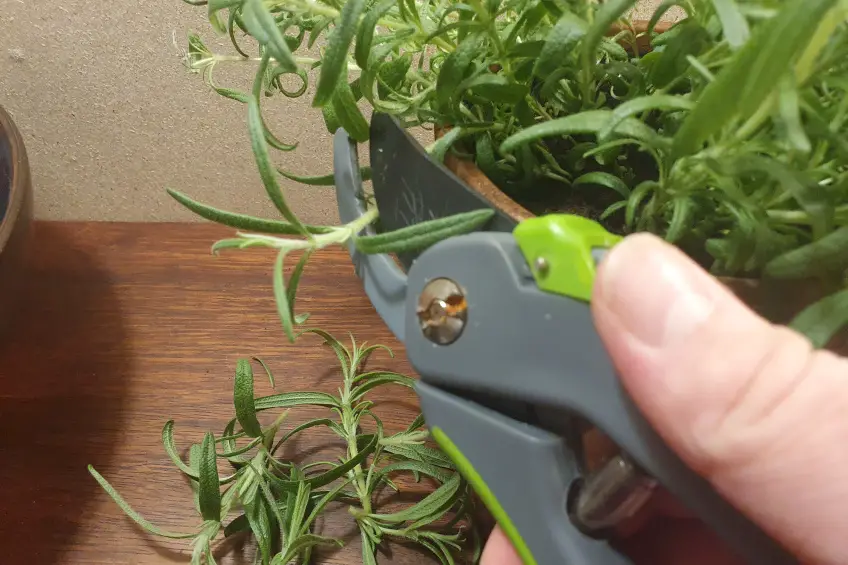
Growing rosemary is fun since you can prune it and shape it pretty much however you want. I like to make my rosemary bushy so if that sounds like something you want as well, let me teach you how you can make your rosemary bushy too.
Pruning and trimming are the keys to making rosemary bushy. Trimming rosemary forces the branches to split in two which makes the plant bushier. Prune rosemary by cutting at least 2 inches (5 cm) off of each branch you wish to prune but do not remove more than a third of the entire plant at the same time.
In this post, you will, first of all, learn how you can easily make your rosemary much bushier by pruning it right. Giving rosemary proper growing conditions is also important for growing the best rosemary bushes, so at the end of the post, you will find a table I made to give you a quick and easy overview of how you can give your rosemary the best growing conditions to grow better, bushier plants.
How to Make Rosemary Bushy
When I grow rosemary, I like to make it bushy since it is an easy way of increasing the overall yield from the plant without having it take up more space. On top of that, rosemary bushes look great and spread a nice aroma that makes their surroundings smell like fresh pine.
The key to growing the best rosemary bushes is a combination of proper pruning and good growing conditions. Prune rosemary by cutting the tips off all the branches as this makes them spread into two. Rosemary grows best in temperatures between 68-86°F (20-30°C) and when it gets 6-8 hours of direct sunlight per day.
Another thing you can do to make your rosemary even bushier is to take the cuttings you get when you prune it and grow them as new plants. I have a guide where I show you how to do that here.
Below, I will go much more in-depth with the process of pruning rosemary including how exactly you should do it and why it is a good idea. After that, I will dive more into how you can give your rosemary the best conditions since good conditions will not only improve the plant’s health but also make it much easier and faster to make your rosemary bushy.
Pruning Rosemary to Make It Bushy

Unlike many other plants, rosemary does actually not require pruning to stay healthy and grow well. If you want a bushy plant, however, correct pruning is the way to do it.
I have written another post where I cover three good reasons why you should prune your rosemary. You can find that post on this link.
When pruning your plants, it is important to always use sharp, clean pruning shears to reduce the risk of pests or diseases attacking your plants. You have probably heard that before, but it is worth repeating since it can save you a lot of time and headaches.
To make rosemary bushy, prune it by cutting at least 2 inches (5 cm) from each branch as this makes them split, but do not remove more than a third of the plant at once. Remove branches that are turning yellow or brown and dry entirely or cut the branches where the issue begins. Prune in the spring to optimize growth.
The fact that rosemary branches split when they are cut is ultimately what makes them more dense and bushy.
I like to prune rosemary in the spring, but you can do it throughout most of the year as long as the plant is not going to be exposed to frost for at least 2 months.
The reason why I prefer to prune rosemary in the spring is that the new shoots that grow out where I cut the branches will be exposed to mild weather at first and then to more and more direct sunlight to provide them with lots of energy for as long as possible as they grow throughout the summer.
If you want to reduce the size of your rosemary plant or bush, be careful not to prune it too much at the same time. Do not remove more than a third of the plant at the same time. If you want to make your rosemary smaller than that, wait at least 3 months before pruning more and only prune when there is no frost.
Being exposed to frost can kill fresh shoots so if you think there is a chance that the temperatures get too low within the next 2 months, save the pruning for spring. The same goes for yellow or brown and dry branches or leaves. Leave them until spring.
The exception to this rule is if you see signs of disease or pests in your rosemary. In this case, you should remove the affected branches or leaves to prevent them from spreading to other parts of the plant.
I love when it is time to prune my rosemary since it is not only time to make the plant even denser and bushier which in itself is nice but it also means that I get to use a lot of the rosemary I remove from my plant for cooking.
I found a short video where the host does a great job of showing and explaining how to prune rosemary to make it bushy so if you have a few minutes, you can see it here. He cuts a bit more than I would probably have done but it seems to work very well anyway.
Growing the best rosemary bushes is not just about pruning. Perhaps even more important than pruning is giving your rosemary the right conditions since this will not only improve the plant’s health but also significantly boost its growth and production.
Best Growing Conditions for Rosemary
I made a table to give you the fastest and easiest overview of what the ideal growing conditions for rosemary are.
If you are interested in a more in-depth explanation of how you can give your rosemary the ideal growing conditions, I encourage you to head over to this post where I go much more in-depth with that.
Here is the cheat sheet for giving rosemary the best growing conditions:
| Direct sunlight | 6-8 hours |
| Temperature | 68-86 F (20-30 C) |
| Watering | Weekly |
| Fertilizer | Every 1-2 months |
| Soil | Slightly alkaline (7-8 pH) |
In my experience, rosemary is a pretty strong and sturdy plant, but it does grow significantly faster and better when the conditions are right.
As with anything gardening-related, how you should take care of your plants depends on your specific situation.
For instance, large rosemary bushes that grow directly in the ground do not need watering very often if ever since their root systems are often large enough to seek out water from the ground. If you experience periods with no rain, however, even large rosemary bushes growing directly in the ground should be watered.
If you are growing rosemary in a pot, a good rule of thumb is to water it when the top inch of the soil is dry. Watering from the bottom rather than from the top of the soil encourages the roots to grow and seek out the water which can lead to better growth.
It is also important to mention that since the sunlight is much more intense in the summer, your rosemary may require watering more frequently than during the rest of the year.
Be careful not to overwater your rosemary since this can cause root rot and potentially kill the plant. I have overwatered rosemary before so when I did, I called a garden center to ask one of their professional gardeners for some advice and it actually worked incredibly well so I decided to write a post to share what I learned with you.
In my experience, rosemary rarely needs fertilizer and too much of it can do much more damage than if you don’t use any at all. I usually give rosemary fertilizer about once every month or two and I like to use an organic, liquid fertilizer that I just mix with the water.

